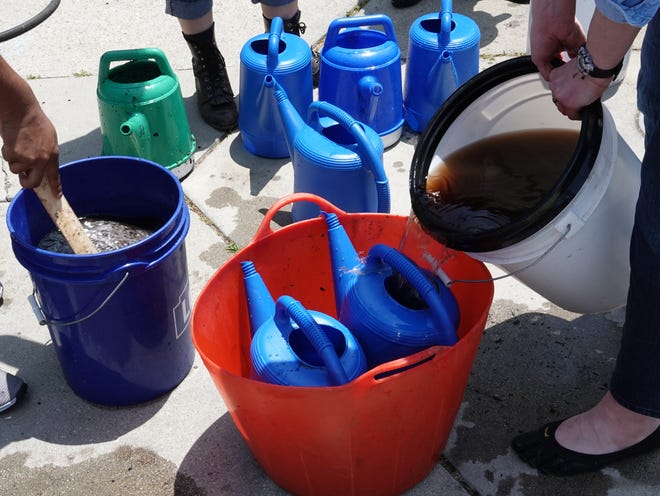Should you add compost tea to help garden plants grow?

Q: I’m adding compost to some areas in my yard for fall planting. I have compacted clay soil that I’m attempting to rehabilitate. Before adding the compost, should I spray actively aerated compost tea on the area? It's so hot, I wonder if the microbes will die if I put it on too early before I get it covered with mulch.
Also, I've heard that you can take a handful of good compost, put it in panty hose into large bucket of water, swish it around and then spray over the area. The pantyhose acts like a tea strainer so that large particles won't clog the sprayer. This would be easier to do than making compost tea with the aerator, but does it really work as well?
A: Adding compost and mixing it into the soil is going to provide a much better benefit to your soil at this stage of your planting preparation then spraying the soil with compost tea. Soil microbes need organic matter, moisture and temperature ranges between 55 and 85 degrees Fahrenheit to be active in soil. Once you have prepared your beds for planting, covering them with cardboard, mulch or other material that will keep them moist and cool will be beneficial.
More gardening help:
- Best mulch for fire protection, plants in your garden
- Bring butterflies to your garden with these plants
- How to compost food scraps, organic waste for your garden plants after California's new law
Actively aerated compost tea is a liquid concentrate that contains all the beneficial microbes found in compost or vermicompost. These living organisms are what feeds the soil food web and make for a healthy functioning soil. Actively aerated compost teas are best used on the plants once they are growing, rather than the soil before planting. They have been found to provide addition disease resistance and increased nutrient uptake in plants. But the microbes do require organic materials to be present in the soil to flourish, so that added compost will be important to maintaining good soil microbe activity.
Actively aerated compost is made by adding good quality compost or vermicompost to non-chlorinated water with food sources and added oxygen from an air pump used in fish tanks. The compost tea is usually made in a 5-gallon bucket and “brewed” with aeration for 24 hours. Food sources can include un-sulphured molasses or other simple sugars for bacteria growth, and fish hydrolysate, kelp or humic acid for fungi growth.
You do not get the same benefits from non-aerated compost tea. In order for the good microbes found in compost to flourish, oxygen needs to be present. If you’re just adding compost to water and not adding the food sources and oxygen, you are just diluting any nutrients found in the compost and not increasing any of the beneficial microbes. In fact, the lack of oxygen in the water may increase the pathogenic bacteria that cause harm to both plants and humans.
For further information on actively aerated compost tea and a recipe for making it, check out this article from the Piedmont Master Gardeners at bit.ly/3cunHje.
The Shasta Master Gardeners Program can be reached by phone at 530-242-2219 or email mastergardener@shastacollege.edu. The gardener office is staffed by volunteers trained by the University of California to answer gardeners' questions using information based on scientific research.